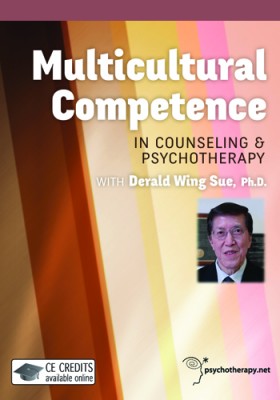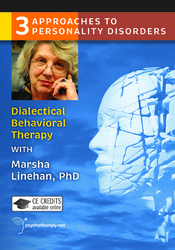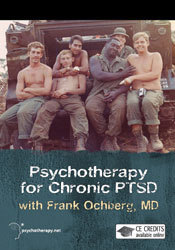Dec 2, 2014 | Video Reviews
 Multicultural Competence in Counseling & Psychotherapy delves into key aspects of multicultural counseling via an interview with Derald Wing Sue conducted by Victor Yalom. In just under an hour and a half, they explore the following topics: color-blindness, micro-aggressions, developing cultural competence, the race lab, the invisible white man, and the caterpillar and the ant. Each discussion offers viewers a candid analysis of these phenomena and their relevance to competent counseling practice.
Multicultural Competence in Counseling & Psychotherapy delves into key aspects of multicultural counseling via an interview with Derald Wing Sue conducted by Victor Yalom. In just under an hour and a half, they explore the following topics: color-blindness, micro-aggressions, developing cultural competence, the race lab, the invisible white man, and the caterpillar and the ant. Each discussion offers viewers a candid analysis of these phenomena and their relevance to competent counseling practice.
Throughout the existentially grounded interview, Sue validates personal and developmental challenges as part of the process of building cultural awareness, knowledge and skill. Sue consistently invites viewers to confront roadblocks to culturally competent practice such as taking a colorblind approach for fear of appearing racist, rigidly apply theories and techniques, experiencing implicit bias, or failing to anticipate our social impact on clients. He also offers practical suggestions for counselor educators, supervisors and trainees such as the use of recording, integration of experiential reality in training and supervision, creating validating and inviting office spaces, and striving for authenticity and reflexivity in practice.
In particular, Sue addresses concepts that inform counselor education and supervision practice through identification and discussion of both challenges and strategies in fostering cultural competence among counselor trainees. Thus, this video is ideally suited for doctoral students and could be used as part of the didactic curricula in courses focused on pedagogy, supervision, leadership and advocacy, or during doctoral fieldwork as students intern as instructors and supervisors. Likewise, the compelling combination of instructional content blended with Sue’s perspective and insights lends itself well to master’s-level counseling courses focused on multicultural counseling and advocacy or fieldwork. Sue’s expertise and personal disclosures have the potential to crystalize concepts for counselor trainees, normalize the challenges of developing cultural competence and inspire students to commit to a continual journey toward cultural competence.
Multicultural Competence in Counseling & Psychotherapy is well suited for classroom use or as an accompaniment to lessons or assigned readings for students engaged in distance learning. It should be noted that while the video can be viewed in one or two sittings, the concepts addressed are complex and may be more than students can digest in one or two sittings. It also should be noted that while the organization of chapter segments may be useful in selecting sections to include in class sessions or to accompany readings, some of the chapter divisions split related content. For example, Sue begins discussing the four major goals of training in the chapter on developing cultural competence and continues in the chapter on the race lab.
Yalom’s interview of Sue provides a platform to evoke Sue’s personal and professional experience as a pioneer in our field. Thus, as Sue addresses each phenomenon, he contextualizes it in a manner that supports a full understanding of its integral relevance to multicultural counseling and therapy. For example, Sue reflects on coming to a Eurocentric field with culturally bound theories and values that not only failed to account for cultural diversity, but also contributed to pathologizing it. The inclusion of his experience exemplifies the problem for viewers, sheds light on the courageous and vital work he and others have done, and underscores the charge to each of us to practice cultural competence and advocacy as counselors, educators and supervisors.
Reviewed by: Amie Manis, NCC, Capella University.
Psychotherapy.net (Producer), & Yalom, V. (Director). (2014). Multicultural Competence in Counseling & Psychotherapy with Derald Wing Sue [DVD]. (Available in DVD and video streaming from http://www.psychotherapy.net/video/multicultural-competence-psychotherapy-sue)
Available in DVD and streaming format as part of video subscription at Psychotherapy.net/subscriptions.
The Professional Counselor
http://tpcjournal.nbcc.org
Jul 11, 2014 | Video Reviews
 Dr. Marsha Linehan, creator of Dialectical Behavioral Therapy (DBT), has developed a valuable DVD that illustrates how impactful the DBT approach can be when working with clients who present with challenging issues (e.g., suicidality, borderline personality disorder). Dr. Linehan explains the basics of DBT while demonstrating and describing this unique approach in a clear and concise way. This DVD is designed to help the viewer understand the key components of this efficacious treatment modality.
Dr. Marsha Linehan, creator of Dialectical Behavioral Therapy (DBT), has developed a valuable DVD that illustrates how impactful the DBT approach can be when working with clients who present with challenging issues (e.g., suicidality, borderline personality disorder). Dr. Linehan explains the basics of DBT while demonstrating and describing this unique approach in a clear and concise way. This DVD is designed to help the viewer understand the key components of this efficacious treatment modality.
DBT is a comprehensive multidiagnostic treatment. To help viewers understand the foundational components of the DBT approach, Dr. Linehan discusses the four basic stages: (1) helping clients struggling with behaviors that may be life-threatening (e.g., suicidality) or that may interfere with their quality of life (e.g., loss of relationships), in order to gain control of such behaviors; (2) focusing on emotional experiencing to reduce traumatic stress; (3) helping clients take ownership of their behaviors and establish trust in themselves; and (4) achieving mindfulness/spirituality with focus on transcendence and building a capacity for joy. Dr. Linehan further enhances this valuable information with an illustration of a behavioral assessment with a challenging client. While observing Dr. Linehan’s interactions with the client in this video, the viewer can see how a thorough behavioral assessment contributes to each of the basic stages of DBT. Dr. Linehan pauses intermittently throughout the video to describe the process of her work, which allows the viewer to comprehend ways to apply DBT to their practice.
The dialectical piece of DBT refers to the balance of opposites: the need for one to change, but also to accept the way he or she is. Dr. Linehan believes that everything in the universe is connected, even both sides of opposites. In this video, she helps the client identify where the truth lies in both ends of opposition. While she hones in on the client’s perception of reality and validates his experience, she also helps him identify alternative perceptions of reality. Mismatches in perceptions are identified and linked to the client’s life challenges, which helps him gain a better understanding of the world around him and the need for behavior modification. Utilizing an assertive yet empathic approach, Dr. Linehan validates the client’s desire not to change, while also challenging this perspective in order to help increase his insight and desire to change. By observing the demonstration in this video, counselors can learn valuable ways to approach clients presenting with challenging issues and diagnoses, and gain a basic understanding of the DBT approach.
In addition to this informative DVD, the viewer receives an instructor’s manual by Katie Read, MFT, filled with useful content (e.g., tips for making the best of the DVD, summary of the DBT approach, discussion questions, related websites, suggestions for additional videos and further reading, etc.). Overall, this DVD is informative, helping the viewer form a clear understanding of the DBT approach. This DVD is ideal for both novice and seasoned counselors working with clients who present with challenging issues and diagnoses and who need to establish and maintain healthy behavior modification.
Reviewed by: Kristina Nelson, doctoral student, University of Central Florida, Orlando, Florida.
Psychotherapy.net (Producer), & Yalom, V. (Director). (2013). Three Approaches to Personality Disorders: Dialectical Behavioral Therapy with Marsha Linehan, PhD [DVD and video streaming]. Available from http://www.psychotherapy.net/video/dialectical-behavior-therapy-linehan
Available in DVD and streaming format as part of video subscription at Psychotherapy.net/subscriptions.
The Professional Counselor
http://tpcjournal.nbcc.org
Jul 11, 2014 | Video Reviews
 Psychotherapy for Chronic PTSD: A Vietnam Vet’s Journey is a 2-hour and 47-minute training DVD appropriate for a classroom and/or training seminar. The DVD features three individuals: Dr. Victor Yalom (serving as the interviewer), Dr. Frank Ochberg (the clinician with expertise in post-traumatic stress disorder [PTSD]), and Terry (Dr. Ochberg’s client who has struggled with PTSD following his experiences in the Vietnam War). One unique aspect of this DVD is that Dr. Yalom candidly interviews both the clinician and the client about the work that occurs between them; their comments demonstrate the tremendous impact of both the therapeutic relationship and the specific techniques that the DVD highlights.
Psychotherapy for Chronic PTSD: A Vietnam Vet’s Journey is a 2-hour and 47-minute training DVD appropriate for a classroom and/or training seminar. The DVD features three individuals: Dr. Victor Yalom (serving as the interviewer), Dr. Frank Ochberg (the clinician with expertise in post-traumatic stress disorder [PTSD]), and Terry (Dr. Ochberg’s client who has struggled with PTSD following his experiences in the Vietnam War). One unique aspect of this DVD is that Dr. Yalom candidly interviews both the clinician and the client about the work that occurs between them; their comments demonstrate the tremendous impact of both the therapeutic relationship and the specific techniques that the DVD highlights.
The DVD begins with a detailed review of PTSD, in which Dr. Yalom interviews Dr. Ochberg. Following this review, Dr. Ochberg begins to describe his treatment regimen, starting with a thorough assessment of the client’s holistic health. Specific areas covered include physical health, nutrition, sense of humor, spiritual beliefs/practices and social relationships. Dr. Ochberg’s unique approach includes elements such as (a) not being the one who opens the door to clients sharing their traumatic experience, (b) connecting current clients with former clients to serve as support networks (with clients’ permission), (c) using creative techniques (e.g., poetry) and (d) involving the family in the treatment process. Dr. Ochberg notes the important fact that there is a crucial need for competent clinicians who are interested in working with clients struggling with PTSD; unfortunately, there are many more clients who need services than there are such clinicians.
Dr. Yalom next interviews Terry about his experience of living with PTSD following the Vietnam War (before starting therapy with Dr. Ochberg). Terry waited 40 years to seek counseling. His motivation to seek treatment, like that of many veterans, was spurred by the recognition of how miserable his life had become. His first attempt at therapy was with a clinician who was unskilled in treating PTSD; luckily, this clinician kept a good referral list of others with the necessary expertise. This is how Terry came to meet with Dr. Ochberg. Next, Terry recounts what he found to be most helpful in working with Dr. Ochberg, including both the relationship and the techniques they used.
Following the interviews of Dr. Ochberg and Terry, the DVD spends the remaining time on various session segments in which Dr. Ochberg and Terry demonstrate the discussed techniques. Drs. Yalom and Ochberg provide commentary to accompany the segments. Among these segments, the value of using the client’s religion/spirituality as a source of meaning-making receives specific focus. During the session, Dr. Ochberg readily admits to having routinely avoided his clients’ religion/spirituality during the early part of his career. He notes that he felt that he was missing a significant source of strength for clients as they created meaning about their traumatic experiences. Terry shares how impactful it was for Dr. Ochberg to explore his belief system, as it helped him to release much of his survivor’s guilt.
The DVD next demonstrates Dr. Ochberg using several therapeutic techniques during the treatment process. Dr. Ochberg first shares a poem he had written about his work with Terry (and other PTSD sufferers). He reads the poem to Terry and experiences his reaction, which seems to constitute a cathartic moment for Terry. Another unique strategy that Dr. Ochberg uses when working with PTSD is Ochberg’s Color Wheel, a pie chart with six colored segments. Each color corresponds to various feelings (and associated thoughts): yellow represents jumping for joy, blue signifies serenity, red reflects love (of others), green signifies self-love/self-respect, orange represents sensual pleasure, and purple reflects spiritual connections. Terry learns to use the wheel as a means of identifying feelings that have been numbed by traumatic experiences, and/or refocusing himself when in the midst of extreme anxiety, anger/rage, depression, etc. In the midst of the session segment, Dr. Ochberg invites Terry to mindfully consider each of the representative colors as a means of soothing an episode of anxiety. Next, Terry explores his anxious thoughts through the filter of the colors.
The final technique that Dr. Ochberg demonstrates is the Counting Method. Clients learn this PTSD-alleviating technique prior to use in the session, and they employ it when their flashbacks and/or intrusive memories are significantly impacting their lives. The clinician provides instructions to properly prepare clients for this technique, which involves clients silently allowing themselves to relive the events as they occurred (with all the associated thoughts and feelings). The clinician counts aloud from 1 to 100, and upon completion of the counting, the client shares what he or she experienced during the counting. The counselor writes down what the client shares and then processes the events in detail. Dr. Ochberg demonstrates this technique with Terry and discusses its purpose and utility.
Accompanying the DVD is an Instructor’s Manual, which serves as a useful adjunct to showing the video in a classroom or training seminar. The manual includes discussion questions that can be used for small groups, reflective writing exercises and the like. Additionally, the manual contains detailed descriptions of the techniques that the DVD demonstrates, including a guided role-play for students/practitioners who desire to practice these techniques. The manual concludes with suggested websites, videos and readings for those who want to pursue additional information on the treatment of PTSD.
The DVD package would be appropriate to use with graduate students in such courses as diagnosis and treatment, trauma counseling and/or a course that focuses on counseling veterans. For practicing clinicians intent on working with trauma survivors and/or combat veterans, this DVD would be a great aid to building their professional competence.
Reviewed by: W. Bryce Hagedorn, NCC, University of Central Florida, Orlando, Florida.
Psychotherapy.net (Producer), & Yalom, V. (Director). (2012). Psychotherapy for Chronic PTSD with Frank Ochberg, MD [DVD and video streaming]. Available from http://www.psychotherapy.net/video/ptsd
Available in DVD and streaming format as part of video subscription at Psychotherapy.net/subscriptions.
The Professional Counselor
http://tpcjournal.nbcc.org
Jun 5, 2014 | Video Reviews
 In this 4-hour and 16-minute video, psychotherapist Otto Kernberg demonstrates Transference-Focused Psychotherapy (TFP) in three live sessions with a 40-year-old patient named Alfred (portrayed by an actor). TFP is an evidence-based treatment that is effective for individuals struggling with personality disorders. It is specifically helpful for individuals with borderline and narcissistic personality disorders, and focuses on treating the individual’s entire personality.
In this 4-hour and 16-minute video, psychotherapist Otto Kernberg demonstrates Transference-Focused Psychotherapy (TFP) in three live sessions with a 40-year-old patient named Alfred (portrayed by an actor). TFP is an evidence-based treatment that is effective for individuals struggling with personality disorders. It is specifically helpful for individuals with borderline and narcissistic personality disorders, and focuses on treating the individual’s entire personality.
Kernberg engages in TFP with Alfred, who suffers from a personality disorder. Using a psychodynamic TFP approach, Kernberg demonstrates how therapists can conduct treatment. From the TFP perspective, personality disorders develop due to dysfunction in early life as well as genetic factors. They can specifically occur due to insecure attachment to a caregiver, severe trauma and/or severe family pathology that is transmitted in the interaction between family members. TFP focuses on helping patients change their distorted perceptions of others, internalized messages, and self-image. Dr. Kernberg builds a relationship with Alfred to demonstrate how this can be accomplished in a therapeutic setting, by using transference analysis, interpretation, and technical neutrality.
For example, during the first session, Alfred becomes suspicious of Dr. Kernberg because he perceives him as taking the side of his previous therapist. Dr. Kernberg confronts the patient about his contradictory attitudes and reinforces the realistic side of Alfred’s statement. He also interprets Alfred’s desire to leave therapy as a fear of attack and betrayal by everyone, including the therapist.
In subsequent sessions, Kernberg responds to Alfred’s distorted views of his relationships, particularly with his ex-girlfriend. Kernberg intermittently interjects his commentary for the viewer throughout the sessions. He helps explain common symptoms of personality disorders and applies them directly to what transpires within each session. He also explains each session’s progress as well as the reasoning for his questions, which helps the viewer understand the theory and how to use it.
The video is supplemented with an instructor’s manual which offers valuable tips for making the best use of the video. The instructor’s manual contains a transcript of the sessions, which helps highlight key moments in the video. It also contains discussion questions that can be used to facilitate dialogue. For example, in session two, one of the discussion questions addresses the patient’s feelings of betrayal as follows: “What do you think of Kernberg’s straightforward way of interpreting Alfred’s avoidance of feelings of betrayal? How do you imagine different clients responding to this style? How does it match or differ from your own?” The instructor’s manual also contains suggestions for activities related to the video, such as a reaction paper and role-play exercise. The instructor’s manual is useful, but a little difficult to navigate.
This video seems appropriate for a relatively higher-level mental health professional or student. It offers a unique perspective on the therapeutic techniques of TFP. Unlike reading a textbook, watching this video gives the viewer a comprehensive understanding of the theory, effectively bringing it theory to life. The video could be a useful teaching tool for instructors and learning tool for students.
Reviewed by: Nicole Berry, Barry University.
Yalom, V. (2007). Psychoanalytic Psychotherapy with Otto Kernberg, MD [DVD]. Mill Valley, CA: Psychotherapy.net.
Available at http://www.psychotherapy.net
Mar 14, 2014 | Video Reviews
 Whether a counselor is working with a mother experiencing anxiety and depression, a man presenting with severe social anxiety, a teacher with panic symptoms, an individual battling chronic pain, or a recovering alcoholic, Hayes and other contributing therapists in the ACT in Action DVD Series provide a solid foundation for practitioners to understand the main principles and processes involved in Acceptance and Commitment Therapy (ACT). Hayes effectively delivers in each of his 6 DVDs, providing extensive details and instruction. For each DVD, Hayes further created an instructor’s manual resource that includes a complete transcript, summarizes basic treatment principles and strategies, offers discussion questions, and provides information on additional websites, readings, and videos.
Whether a counselor is working with a mother experiencing anxiety and depression, a man presenting with severe social anxiety, a teacher with panic symptoms, an individual battling chronic pain, or a recovering alcoholic, Hayes and other contributing therapists in the ACT in Action DVD Series provide a solid foundation for practitioners to understand the main principles and processes involved in Acceptance and Commitment Therapy (ACT). Hayes effectively delivers in each of his 6 DVDs, providing extensive details and instruction. For each DVD, Hayes further created an instructor’s manual resource that includes a complete transcript, summarizes basic treatment principles and strategies, offers discussion questions, and provides information on additional websites, readings, and videos.
During the first video of this series, Facing the Struggle, Hayes beautifully normalizes the human condition, shows how pain represents an ally, and demonstrates the process of obtaining informed consent using an ACT approach. In his second video, Control and Acceptance, Hayes delicately illustrates techniques to help clients accept what they cannot control and behave based on personal values. This video uses appropriate self-disclosure and provides the audience with warning signs and strategies to overcome what Hayes labels “pseudoacceptance.” Similarly, in video three, Cognitive Defusion, clinicians implement a variety of thought-diffusion techniques, such as deliteralization, and physicalizing, which can be easily integrated into therapists’ toolboxes and used to reduce anxiety and depression. Appropriate metaphors allow Hayes to connect with material presented in earlier DVDs.
During the fourth DVD, Mindfulness, Self, and Contact with the Present Moment, Hayes provides the audience with a fruitful dialogue on mindfulness practices. Specifically, he demonstrates using an eyes-closed exercise with a recovering addict to promote self-mind-body connection and deeper engagement in therapy. In this DVD, ACT co-founder Kelly Wilson further demonstrates the utility of ACT in clinical supervision with another therapist working with a resistant client. In this segment, viewers observe powerful role-plays and other empowering techniques for ACT therapists.
Values and Action and Psychological Flexibility, the fifth and sixth DVD in the series, demonstrate how each prior process, component, and ACT technique build upon and work together. Values and Action highlights the significance of values in psychotherapy and the importance of identifying, incorporating, and creating meaningful goals based on personal values. In the example of working with a client diagnosed with Obsessive-Compulsive Disorder (OCD), exposure exercises are implemented and viewers observe what it means for clients to remain in the present moment without engaging in defense mechanisms, while concurrently remaining grounded and practicing psychological flexibility. These final two DVDs are highly active and show the ways that ACT can be applied across gender, age, race, socioeconomic status, disability status and cultural background.
In this DVD series, the authors do a sufficient job of demonstrating how clinicians with a variety of therapeutic styles can adopt components of ACT in their own practices, while also noting that this approach is no better than others. For example, Hayes demonstrates how ACT serves as a brief but integrative approach, combining elements from mindfulness, cognitive-behavioral therapy and interpersonal therapy. Throughout the series, Hayes provides summaries and explanations for what he is doing and why to enhance the understanding of his audience.
While this series includes numerous strengths, several caveats and limitations should be noted. At times, the terminology is complex and vague (e.g., cognitive entanglement; creative hopelessness) and it would be helpful to give visual and written definitions, or at least link audience members not as familiar with ACT to specific handouts to obtain such definitions. Another area for improvement relates to the video recording procedures; at times, the camera zooms in on Hayes and the audience may benefit from seeing the client’s non-verbal behaviors or reactions to Hayes. Third, a gun analogy is used during Control and Acceptance and the current reviewer found this technique somewhat violent and inappropriate to use with clients. Finally, the DVD series would be more complete if it included Hayes using ACT to work with a resistant client.
Watching these DVDs is probably more helpful than reading books and articles, as audience members visually observe key processes involved in ACT. Additionally, clinicians and other professionals in the field who are interested in honing his/her ACT skills can learn practical tools to use in psychotherapy with over twelve hours of instruction, live sessions and diverse therapeutic case examples. The author skillfully enlists several ACT therapists from across the United States to participate in this DVD series, including Ann Bailey-Ciarrochi, JoAnne Dahl, Rainer Sonntag, Kirk Strosahl, Robyn Walser, Rikard Wicksell, and Kelly Wilson. In summary, viewers will develop significant insight into applying ACT with a variety of clients and in numerous therapeutic settings after watching this entire series.
Visit http://www.psychotherapy.net/ to read more about the series.
Hayes, S.C. (Ed.). (2007). ACT in Action DVD Series. Oakland, CA: New Harbinger.
Reviewed by: Mary-Catherine McClain, Johns Hopkins University Counseling Center, Baltimore, MD.
The Professional Counselor
HOME PAGE
Mar 27, 2013 | Video Reviews
 In these videos, Sam Steen, Ph.D., and Sheri Bauman, Ph.D., utilizes therapeutic interventions in their group counseling collaboration to create effective ways of educating children about diversity. Steen and Bauman introduce the video by sharing the necessary steps in group formulation and preparation: planning, screening, modeling, self-disclosure (not too personal), processing (reflect, think and ponder) and evaluating (age appropriate and specific to the group). Throughout these videos, counselors are instructed in how to replicate groups.
In these videos, Sam Steen, Ph.D., and Sheri Bauman, Ph.D., utilizes therapeutic interventions in their group counseling collaboration to create effective ways of educating children about diversity. Steen and Bauman introduce the video by sharing the necessary steps in group formulation and preparation: planning, screening, modeling, self-disclosure (not too personal), processing (reflect, think and ponder) and evaluating (age appropriate and specific to the group). Throughout these videos, counselors are instructed in how to replicate groups.
Steen and Bauman co-facilitate this group to help these children understand cultural diversity, or multiculturalism. They create a safe environment in which children can interact, and they teach diversity using fun educational tools such as ice cream and songs. Therefore, demonstrating diversity is constantly prevalent in our surroundings.
A unique perspective on the demonstration of activities is displayed in this video, which also illustrates how a therapeutic bond is formed. This positive bond between youth and counselor can be based on relational features, such as the degree to which the therapist is being stimulating, humorous or rewarding, especially with young children. The video is exceptional in how the children are addressed and encouraged to engage.
The lack of cognitive development can limit a younger client’s ability to evaluate connections between therapy tasks and goals, and the involvement of parents and other caregivers in youth therapy can complicate the issue of goal consensus. Steen and Bauman effectively illustrate how to go beyond such roadblocks to create a therapeutic alliance and establish treatment outcomes for these multicultural issues.
Throughout the video, Steen and Bauman illustrate both humorous and serious themes that can be addressed in diversity. There are a total of six (6) sessions, all of which contain information that a therapist can take away and utilize when leading groups, or even with younger individual clients. Different activities are carried out throughout the sessions, such as “diversity beans,” “name color,” “comfort zones,” and “about your culture,” to name a few. Some of these can be used in the classroom to make children more aware of diversity, whether it will be processed further than the surface level observations or not. Although every activity has an element of fun, each activity is effective and always follows through with purpose and reflections. Despite the fact that counselors and clients were videotaped, they were able to give an accurate depiction of group dynamics and cohesion, as well as therapeutic practices and outcomes.
While therapeutic styles are personal and are as important as techniques and theories, counselors can utilize these techniques to blend with their own styles and the needs of their clients to produce valuable outcomes. This video shows that Steen and Bauman are successful in demonstrating a practical and technical approach using innovative techniques and activities.
I would highly recommend this video to anyone who works with younger clients even if it is only to add techniques to your battery of information to help these young people view the world in a new way by appreciating differences.
Psychotherapy.net (Producer), & Gallego, T. (Director). (2011). Group counseling with children: A multicultural approach [DVD]. Available in DVD and video streaming from http://www.psychotherapy.net/video/diversity-group-children
Reviewed by: Josephine L. Rodriguez, NCC, doctoral counseling student, Barry University, Miami Shores, Florida.
The Professional Counselor Journal
HOME PAGE
 Multicultural Competence in Counseling & Psychotherapy delves into key aspects of multicultural counseling via an interview with Derald Wing Sue conducted by Victor Yalom. In just under an hour and a half, they explore the following topics: color-blindness, micro-aggressions, developing cultural competence, the race lab, the invisible white man, and the caterpillar and the ant. Each discussion offers viewers a candid analysis of these phenomena and their relevance to competent counseling practice.
Multicultural Competence in Counseling & Psychotherapy delves into key aspects of multicultural counseling via an interview with Derald Wing Sue conducted by Victor Yalom. In just under an hour and a half, they explore the following topics: color-blindness, micro-aggressions, developing cultural competence, the race lab, the invisible white man, and the caterpillar and the ant. Each discussion offers viewers a candid analysis of these phenomena and their relevance to competent counseling practice. Dr. Marsha Linehan, creator of Dialectical Behavioral Therapy (DBT), has developed a valuable DVD that illustrates how impactful the DBT approach can be when working with clients who present with challenging issues (e.g., suicidality, borderline personality disorder). Dr. Linehan explains the basics of DBT while demonstrating and describing this unique approach in a clear and concise way. This DVD is designed to help the viewer understand the key components of this efficacious treatment modality.
Dr. Marsha Linehan, creator of Dialectical Behavioral Therapy (DBT), has developed a valuable DVD that illustrates how impactful the DBT approach can be when working with clients who present with challenging issues (e.g., suicidality, borderline personality disorder). Dr. Linehan explains the basics of DBT while demonstrating and describing this unique approach in a clear and concise way. This DVD is designed to help the viewer understand the key components of this efficacious treatment modality. Psychotherapy for Chronic PTSD: A Vietnam Vet’s Journey is a 2-hour and 47-minute training DVD appropriate for a classroom and/or training seminar. The DVD features three individuals: Dr. Victor Yalom (serving as the interviewer), Dr. Frank Ochberg (the clinician with expertise in post-traumatic stress disorder [PTSD]), and Terry (Dr. Ochberg’s client who has struggled with PTSD following his experiences in the Vietnam War). One unique aspect of this DVD is that Dr. Yalom candidly interviews both the clinician and the client about the work that occurs between them; their comments demonstrate the tremendous impact of both the therapeutic relationship and the specific techniques that the DVD highlights.
Psychotherapy for Chronic PTSD: A Vietnam Vet’s Journey is a 2-hour and 47-minute training DVD appropriate for a classroom and/or training seminar. The DVD features three individuals: Dr. Victor Yalom (serving as the interviewer), Dr. Frank Ochberg (the clinician with expertise in post-traumatic stress disorder [PTSD]), and Terry (Dr. Ochberg’s client who has struggled with PTSD following his experiences in the Vietnam War). One unique aspect of this DVD is that Dr. Yalom candidly interviews both the clinician and the client about the work that occurs between them; their comments demonstrate the tremendous impact of both the therapeutic relationship and the specific techniques that the DVD highlights. In this 4-hour and 16-minute video, psychotherapist Otto Kernberg demonstrates Transference-Focused Psychotherapy (TFP) in three live sessions with a 40-year-old patient named Alfred (portrayed by an actor). TFP is an evidence-based treatment that is effective for individuals struggling with personality disorders. It is specifically helpful for individuals with borderline and narcissistic personality disorders, and focuses on treating the individual’s entire personality.
In this 4-hour and 16-minute video, psychotherapist Otto Kernberg demonstrates Transference-Focused Psychotherapy (TFP) in three live sessions with a 40-year-old patient named Alfred (portrayed by an actor). TFP is an evidence-based treatment that is effective for individuals struggling with personality disorders. It is specifically helpful for individuals with borderline and narcissistic personality disorders, and focuses on treating the individual’s entire personality. Whether a counselor is working with a mother experiencing anxiety and depression, a man presenting with severe social anxiety, a teacher with panic symptoms, an individual battling chronic pain, or a recovering alcoholic, Hayes and other contributing therapists in the
Whether a counselor is working with a mother experiencing anxiety and depression, a man presenting with severe social anxiety, a teacher with panic symptoms, an individual battling chronic pain, or a recovering alcoholic, Hayes and other contributing therapists in the  In these videos, Sam Steen, Ph.D., and Sheri Bauman, Ph.D., utilizes therapeutic interventions in their group counseling collaboration to create effective ways of educating children about diversity. Steen and Bauman introduce the video by sharing the necessary steps in group formulation and preparation: planning, screening, modeling, self-disclosure (not too personal), processing (reflect, think and ponder) and evaluating (age appropriate and specific to the group). Throughout these videos, counselors are instructed in how to replicate groups.
In these videos, Sam Steen, Ph.D., and Sheri Bauman, Ph.D., utilizes therapeutic interventions in their group counseling collaboration to create effective ways of educating children about diversity. Steen and Bauman introduce the video by sharing the necessary steps in group formulation and preparation: planning, screening, modeling, self-disclosure (not too personal), processing (reflect, think and ponder) and evaluating (age appropriate and specific to the group). Throughout these videos, counselors are instructed in how to replicate groups.